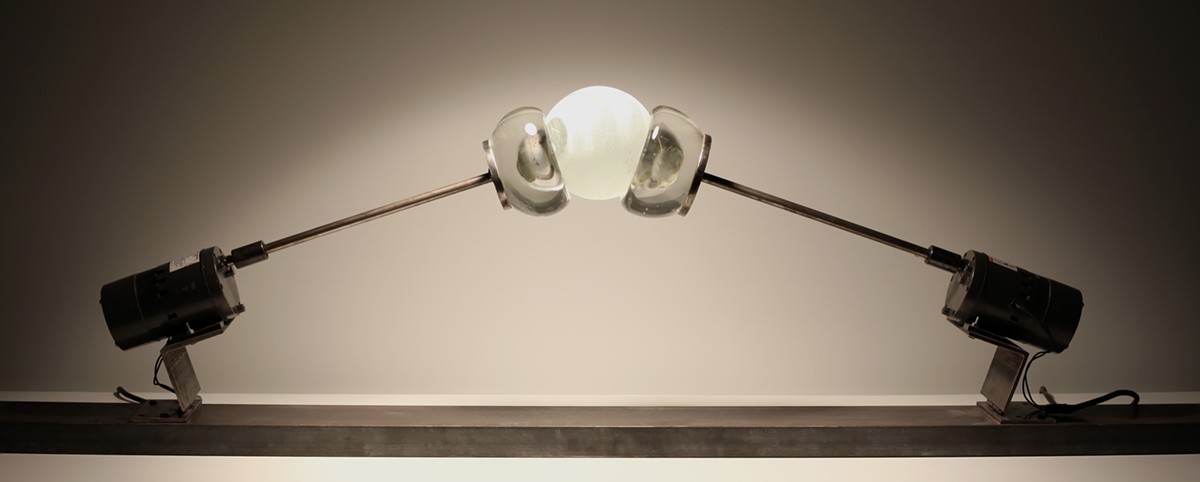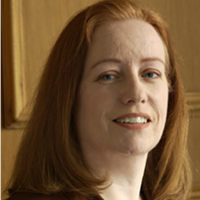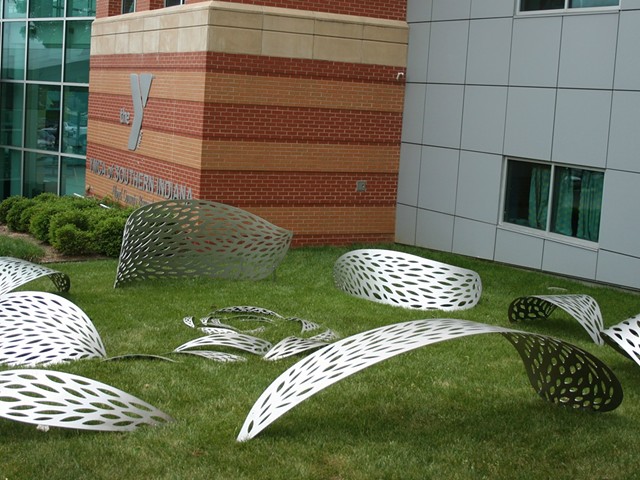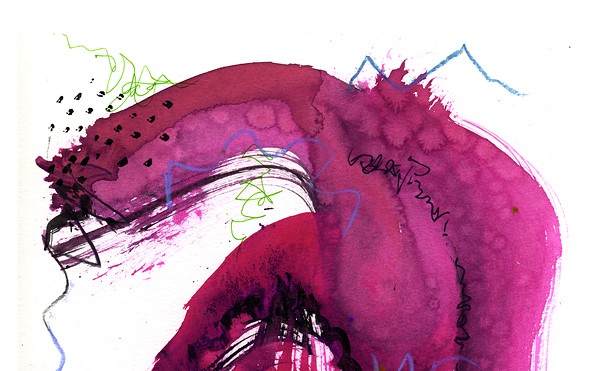[The above image is “Sphere” by Che Rhodes.]
Che Rhodes (cherhodes.com) is the head of the glass program at the University of Louisville’s Hite Art Institute.
LEO: Time certainly flies. It’s been ten years since you started the glass program at the University of Louisville. You and the students even built the ovens. How has the program changed and expanded over the years?
Che Rhodes: In the ten years since I was hired at U of L, ostensibly, the biggest changes for the glass area have been the construction of the Cressman Center, where all of the glass classes are taught, and the recent implementation of the MFA curriculum in Fine Arts. These are both punctuating events, and personally, I think of the construction and completion of the Cressman Center facilities as the true beginning of the glass program at U of L. However, from my perspective, the most significant and gratifying changes have been somewhat more gradual and evolutionary in nature. I was very lucky to have a good crop of students from the onset. That first wave of students had to be very pioneering. They had no upperclassmen in their area to whom they might look for a target of performance or expectation. So, to answer the question, I think the most significant and rewarding developments for me have come in tracking back the evolution of the students as a group over time. When I take a step back, I can see how the depth and sophistication of content, concept and execution in the students’ work has increased over the years. It is kind of an institutional phenomenon where one generation of students sets a standard for the next, and within the context of a communal learning environment, assists them in navigating up to, and ideally, beyond that standard.
LEO: You were taught by the godfather of Kentucky glass, Stephen Powell. Was glass on your radar and that’s why you went to Centre College?
CR: After being thrown out of a prominent New England boarding school as a junior, dropping out of high school and then somehow, at the last minute, finishing my senior year at a public creative and performing arts school in Cincinnati, I had no plans to attend college. Eleven days before the start of classes that September, I first heard of, visited and, I believe through some kind of humbuggery, matriculated at Centre College. So the short answer is no, I did not attend Centre College with the intent of studying under Stephen Powell. Ironically, however, sometime during my freshman year at Centre, I vaguely recalled that my senior year high school art teacher had given a very informal presentation about regional artists or schools or something and she showed an image of Steve's work, an actual poster. In about five seconds, she probably told us everything she knew about him — he was a glassblower at Centre College. I knew nothing about glassblowing and I remember thinking, "I wonder how he gets those colors in there." And, as quickly as the thought entered my head, it was gone. But I was exceptionally fortunate to end up as his student. No one has been a greater influence upon me than Stephen Powell. I frequently say that had I not met him, I would most likely be incarcerated or interred. Additionally, his contributions to the field of glass art in this region are unparalleled.
LEO: Artists find inspiration from unusual sources. What has sparked the art you’re creating now?
CH: Lately, perhaps for a while now, I have been spending more time working on my studio than in my studio. However, some time ago, I changed gears a bit and decided to take a somewhat more personal approach to making work, mostly as a mildly sardonic challenge to myself. I typically don't respond to overly personal work, so I thought I would attempt to make some personal work. To some extent, it's probably also a way to give myself permission to stretch out a little bit. I've also been giving myself parameters within which to work that I generally might find disagreeable, like working with text … or feces. Recently, I have also been experimenting with computer modeling and 3-D output devices. I have been thinking about where these processes reside in relationship to the tangible and intangible aspects of our world and culture.
LEO: I’m not saying anything new when I state the history of art is largely about the creativity of straight white men. We seem to have largely gotten over these limitations. Have you seen more ethnicities and women getting into glassblowing?
CR: I'll speak about glass art rather than glassblowing for this one. If I had to guess, I would guess that the number of minorities in glass has increased slightly. But there are so few, that it is hard to track. And I think it also depends on who is classified as a minority. However, I think that the lack of minorities is more a result of general social mores and much less a reflection of the glass art community. I was once on a panel that was charged with discussing what it was like to be a glass artist of color. I discovered that all the other panelists were just as reluctant as I to participate. None of us had any stories, at all, to share of discrimination or adversity encountered from the glass art community. In the end, it probably has more benefits than deficits. I think the issue surrounding women working with glass is more complex and has a longer, more spotted history. I can't speak to the experiences or impressions of women in the field, but the contemporary climate seems to be fairly gender balanced. Glass art definitely has a history and a reputation or perception of being a male-dominated field. And while I have never experienced or heard of any instances of racism, I have seen, on occasion, examples of sexism. What many people do not realize is that the Harvey Littleton's first classes in glass consisted primarily of female students. At that time (‘60s and ‘70s), the art classes at University of Wisconsin were part of arts and crafts, which was a part of home economics, an area that accommodated mainly female students. A number of complex factors, including certain negative attitudes toward women, probably contributed to the successive male-dominance of the field. I remember this still being a lingering issue early on when I was a student. But now, I feel as though things have to some degree equalized. Usually 75 percent or more of my students are women, which is not uncommon in art schools these days. When we discuss issues of gender or sexism within the field of glass art, the students usually seem surprised to know that it was, in the fairly recent past, an issue. I think their experience today is less tempered by underrepresentation of and negative attitudes toward women than it was for many of the female glass artists a few decades ago. Recently, some of the U of L glass students were discussing how they didn't necessarily feel discrimination or adversity as women working with glass, but that they did enjoy the sense of solidarity or sorority that they experienced from having female peers and contemporaries.
LEO: What do you wish Louisville had that it doesn’t when it comes to art, especially glass?
CR: Selfishly, I would like to see, among other things, a downtown facility dedicated to U of L's new MFA program. It would provide for the students and the program not only an environment in which to pursue their creative research and execute their work, but it would also give them, as individuals, and the program, as a whole, a sense of identity. Furthermore, a dedicated downtown facility would provide the Department of Fine Arts with a venue in which to execute its charge of furthering the field of art and enhancing the community.







